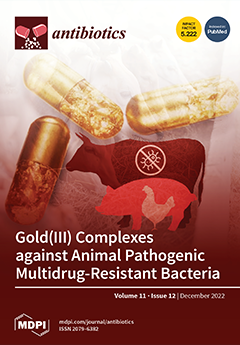Escherichia coli infections (including APEC) in broiler chickens are not only a health and economic problem of the flock, but also a significant health threat to poultry meat consumers. The prophylactic and therapeutic effects of the phytobiotic composition on
E. coli in broiler chickens were previously described. However, most of the data were related to the reference strains (for both in vitro and in vivo models). Based on the previous studies in human and animals,
E. coli strains seem to be multidrug resistance. This, in turn, makes it necessary to develop effective alternative methods of treating this type of infection already at the stage of poultry production. In the present study, the antibacterial activity against various strains of
E. coli (including APEC) was assessed for two innovative phytobiotics mixtures: H1, containing thymol, menthol, linalool,
trans-anethole, methyl salicylate, 1,8-cineol, and
p-cymene; H2, in addition to compounds from H1, containing terpinen-4-ol and γ-terpinene. The unique mixtures of phytobiotics used in the experiment were effective against various strains of
E. coli, also against APEC, isolated from broiler chickens from traditional industrial breeding, as well as against those showing colistin resistance. The minimum inhibitory concentration (MIC) values for these unique mixtures were: For H1 1:512 for APEC and non-APEC
E. coli strains isolated from day old chicks (DOCs), 1:512 for non-APEC, and 1:1024 for non-APEC isolated from broilers sample. For mixture H2, MIC for APEC from both type of samples (DOCs and broilers) was 1:1024 and for non-APEC (DOCs and broilers) was 1:512. The results suggest that phytobiotic compositions used in this study can be successfully used as a natural alternative to antibiotics in the treatment of
E. coli infections in broiler chickens. The promising results may be a crucial point for further analyses in broiler flocks exposed to
E. coli infections and where it is necessary to reduce the level of antibiotics or completely eliminate them, thus reducing the risk of foodborne infections.
Full article






